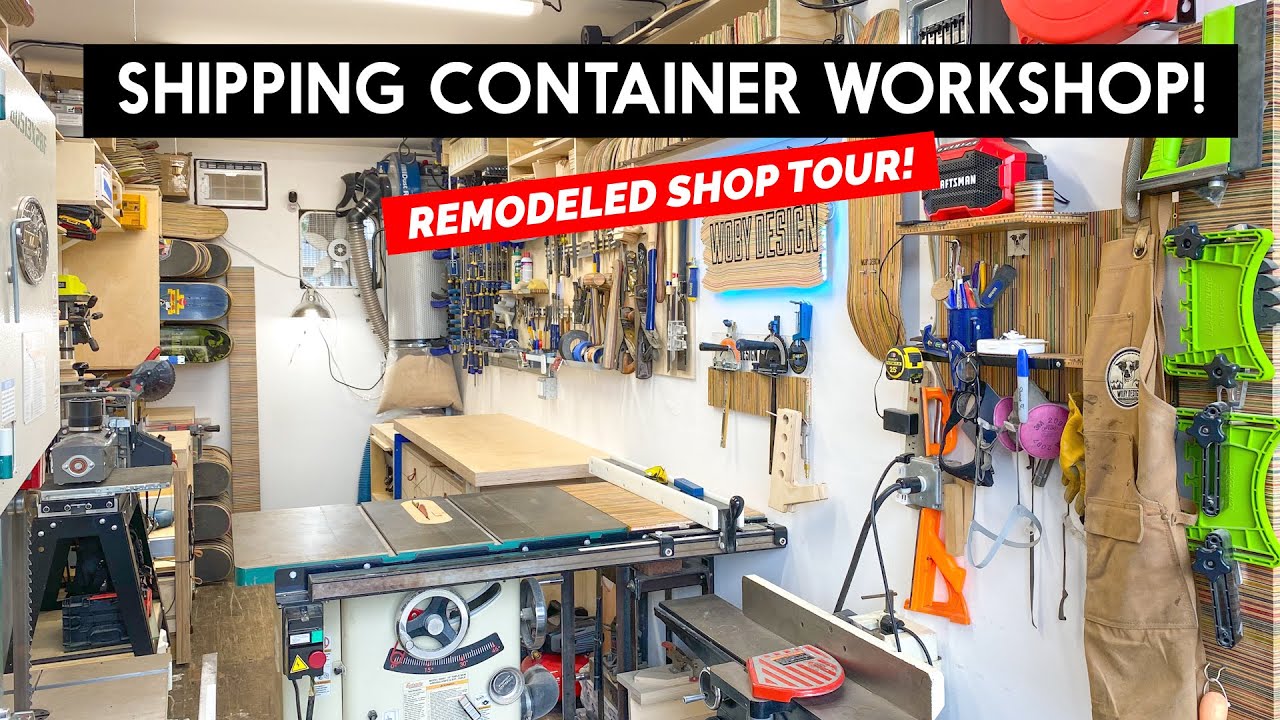For the best small woodworking shop layout, prioritize efficient use of space and easy access to tools. Consider workflow and safety.
Setting up workstations strategically will enhance productivity and organization. A well-thought-out layout can optimize your woodworking shop’s functionality and make your work more enjoyable. By planning your space carefully, you can create a welcoming and efficient environment that supports your woodworking projects.
With the right layout, you can maximize your shop’s potential and create a space that inspires creativity and productivity.
Introduction To Small Woodworking Shops
Discover the optimal layout for a small woodworking shop to maximize space and efficiency. Organize your tools and work areas strategically to create a functional and productive environment for your woodworking projects. Efficient use of space is essential in a small woodworking shop, and the right layout can make a significant difference in workflow and productivity.
The Appeal Of Compact Workshops
Small woodworking shops are becoming increasingly popular among woodworkers due to their affordability, convenience, and ease of use. Compact workshops are particularly attractive to beginners who are just starting out and have limited space. With a small shop, you can easily set up and maintain your tools, making it easy to create beautiful and functional woodwork. In addition, you can save a lot of money by purchasing only the essential tools needed for your projects.Challenges Of Limited Space
One of the biggest challenges of a small woodworking shop is limited space. You need to be able to fit all your tools and equipment into a small area, which can be difficult. You will need to prioritize which tools are most important and which can be sacrificed. You will also need to organize your tools and equipment efficiently so that you can access them easily when needed. To overcome the challenges of limited space, you can use the following strategies:- Invest in space-saving tools and equipment.
- Maximize vertical storage space.
- Use mobile workstations and tables that can be easily moved around the shop.
- Create a layout plan that maximizes your available space.

Credit: www.pinterest.com
Principles Of Efficient Layout Design
Efficient layout design is crucial for small woodworking shops. By optimizing the arrangement of tools, workstations, and storage areas, woodworkers can maximize their productivity and workflow. With careful planning and organization, a well-designed layout can enhance efficiency and make the most of limited space.
Workflow Considerations
When designing the layout for your small woodworking shop, it is essential to consider the workflow. The way you arrange your tools and workstations can greatly impact the efficiency and productivity of your woodworking projects.
One important principle to keep in mind is to group similar tasks together. This means placing tools and equipment that are frequently used together in close proximity. For example, you may want to have a dedicated area for cutting and sawing, another area for sanding and finishing, and a separate space for assembly.
By organizing your shop in this way, you can minimize the time spent moving between different workstations, reducing unnecessary steps and increasing overall productivity.
The Importance Of Flexibility
Flexibility is another key principle to consider when designing your small woodworking shop layout. As your woodworking projects and needs may vary, it is crucial to have a layout that can easily adapt and accommodate different tasks.
One way to achieve flexibility is by using mobile or adjustable workstations and tool stands. This allows you to reconfigure your shop layout based on the specific project at hand. For example, you can easily move a workbench to create more space for larger pieces or adjust the height of a table to accommodate different tasks and working positions.
In addition to mobile furniture, it is also important to have ample storage options that can be easily rearranged. This ensures that you have a designated place for all your tools and materials, keeping your workspace clean and organized. Consider using modular storage systems with adjustable shelves or cabinets on wheels for maximum flexibility.
Html Syntax
When structuring your blog post, it is important to adhere to HTML syntax guidelines for optimal readability and search engine optimization. Here is an example of how the H3 headings can be represented in HTML:
Workflow Considerations
When designing the layout for your small woodworking shop...
The Importance of Flexibility
Flexibility is another key principle to consider...
HTML Syntax
When structuring your blog post, it is important...
By following HTML syntax, you ensure that your content is properly formatted and displayed on your WordPress blog.
Essential Tools For Small Shops
When setting up a small woodworking shop, selecting the right tools is crucial for optimizing space and functionality. In a compact workshop, every tool should serve multiple purposes and be space-efficient. Here are some essential tools for small woodworking shops:
Multi-functional Tools
Benchtop Planer: A versatile tool for dimensioning lumber and creating smooth, flat surfaces.
Combination Square: Ideal for measuring and checking the accuracy of cuts and joinery.
Router Table: Provides a stable platform for a handheld router, allowing for precise shaping and joinery.
Drill Press: Offers accurate drilling and can also function as a spindle sander or mortiser with the right attachments.
Space-saving Equipment Choices
Folding Workbench: Maximizes space when not in use and provides a sturdy work surface when needed.
Compact Table Saw: Offers the functionality of a full-size table saw while requiring less floor space.
Track Saw: Provides the benefits of a table saw for breaking down sheet goods in a smaller footprint.
Compact Dust Collection System: Keeps the workspace clean without occupying excessive floor space.
Strategies For Storage And Organization
When it comes to setting up a small woodworking shop, efficient storage and organization are key factors for maximizing space and productivity. By implementing smart strategies for storage, you can ensure that your tools and materials are easily accessible and your workspace remains clutter-free. In this article, we will explore two essential aspects of storage and organization in a small woodworking shop: vertical storage solutions and mobile bases and workstations.
Vertical Storage Solutions
Utilizing vertical space is a great way to optimize storage in a small woodworking shop. By going vertical, you can make the most of your available floor space and keep your tools and supplies within arm’s reach. Here are some effective strategies for vertical storage:
- Install wall-mounted shelves or cabinets to store frequently used tools and accessories.
- Hang pegboards on the walls to keep hand tools organized and easily accessible.
- Utilize magnetic strips or hooks to hang metal tools, such as chisels and screwdrivers.
- Invest in a sturdy tool rack or tool chest to store larger power tools.
By using vertical storage solutions, you can free up valuable workspace and keep everything neatly arranged and easily accessible.
Mobile Bases And Workstations
In a small woodworking shop, flexibility is key. By incorporating mobile bases and workstations into your layout, you can easily rearrange your workspace to accommodate different projects or workflows. Here are some ideas for incorporating mobility:
- Use wheeled carts or tool chests to store and transport frequently used tools and materials.
- Invest in a mobile workbench with built-in storage for increased functionality.
- Consider using folding or collapsible workbenches that can be easily stored when not in use.
- Install casters on larger tools or work surfaces to make them easily movable.
By having mobile bases and workstations, you can adapt your shop layout to suit your needs, making it easier to work efficiently and effectively.
Optimizing Work Surfaces
When it comes to setting up a small woodworking shop, optimizing work surfaces is crucial for maximizing space and efficiency. By carefully planning the layout and design of work surfaces, woodworkers can create a functional and organized workspace that allows for seamless project execution.
Fold-down Workbench Designs
One space-saving solution for small woodworking shops is the integration of fold-down workbench designs. These versatile workbenches can be easily folded up against the wall when not in use, freeing up valuable floor space. With a sturdy fold-down workbench, woodworkers can enjoy a dedicated work surface for a variety of tasks, from assembly and sanding to hand-tool work and finishing.
Extendable Work Surfaces
Another strategy for optimizing work surfaces in a small woodworking shop is the incorporation of extendable work surfaces. This can be achieved through the use of removable extension wings on existing workbenches or the installation of specialized tables with pull-out extensions. By having the flexibility to expand work surfaces as needed, woodworkers can accommodate larger projects and workpieces without sacrificing space when not in use.
Dust Collection And Ventilation
Proper dust collection and ventilation are crucial in a small woodworking shop layout to maintain a clean and healthy work environment. Implementing compact systems and ensuring good air quality can significantly improve the overall efficiency and safety of the workspace.
Compact Dust Collection Systems
Investing in compact dust collection systems helps in efficiently managing sawdust and wood particles. These systems come in various sizes to suit small spaces, offering powerful suction capabilities.
Maintaining Air Quality In Tight Spaces
In small woodworking shops, maintaining air quality is essential to prevent respiratory issues. Utilize air filtration units and proper ventilation to ensure clean and breathable air.
Lighting And Electrical Setup
Proper lighting and electrical setup are essential in a small woodworking shop. The right lighting ensures precision in your work, while a well-organized electrical system keeps your tools running smoothly.
Task Lighting
- Position LED lights directly above workbenches.
- Use adjustable lamps for specific tasks.
- Natural light is beneficial, place workstations near windows.
Managing Power Supplies
- Install multiple outlets throughout the shop.
- Label circuits for easy identification.
- Consider a dedicated circuit for heavy machinery.

Credit: www.youtube.com
Safety Measures In A Small Shop
To ensure safety in a small woodworking shop, it is important to have a well-planned layout. This includes keeping the work area clear of clutter, having proper lighting, and ensuring tools are stored properly to avoid accidents. By implementing these safety measures, you can create a safe and efficient workspace.
Safe Tool Arrangement
Place tools within easy reach to prevent accidents.
Keep sharp tools in a designated area away from walkways.
Emergency Preparedness
Maintain clear exit paths for quick evacuation.
Store a fire extinguisher in a visible spot for emergencies.
Innovative Ideas From Expert Woodworkers
Case Studies
See how top woodworkers optimize their small spaces:
- Maximizing vertical storage with shelving units
- Creating multi-functional workstations
- Utilizing sliding tool racks for easy access
Tips From The Community
Learn from experienced woodworkers:
- Keep layout flexible for different projects
- Invest in quality lighting for precision work
- Use mobile workbenches for versatility
Diy Projects To Enhance Your Shop Layout
Looking to take your small woodworking shop to the next level? These DIY projects will help you optimize your shop layout for maximum efficiency and functionality. From custom storage solutions to building your own shop furniture, these projects are not only practical but also a great way to personalize your workspace.
Custom Storage Solutions
When it comes to small woodworking shops, custom storage solutions are essential for making the most of limited space. Utilize every inch of your shop with wall-mounted tool racks, rolling storage carts, and adjustable shelving units. These DIY storage projects can be tailored to fit your specific tools and materials, keeping everything organized and easily accessible.
Shop Furniture Plans
Building your own shop furniture allows you to create a workspace that suits your needs perfectly. From sturdy workbenches to space-saving fold-down tables, there are endless possibilities for customizing your shop furniture. With the right plans and materials, you can construct durable and functional furniture that complements your shop layout.
Final Thoughts
For the best small woodworking shop layout, consider the final thoughts. Efficient use of space, easy access to tools, and proper lighting are essential. A well-organized layout can enhance productivity and creativity in your woodworking shop.
Evolving Your Shop Layout
As your woodworking skills grow and your needs change, it’s important to be adaptable and flexible with your small woodworking shop layout. By constantly evolving and optimizing your layout, you can create a more efficient and productive workspace. Here are some tips to help you evolve your shop layout: 1. Reassess your workflow: Regularly evaluate how you move around your shop and identify any bottlenecks or areas that can be improved. Rearranging your tools and workstations can make a significant difference in your efficiency. 2. Maximize space utilization: Make the most of your limited space by utilizing vertical storage solutions, such as wall-mounted racks and shelving. This will free up valuable floor space for larger machinery or work areas. 3. Consider mobility: Invest in tools and workstations that are mobile or can be easily repositioned. This will allow you to adapt your layout for different projects or accommodate larger pieces of wood. 4. Prioritize safety: Ensure that your shop layout promotes a safe working environment. Keep emergency exits clear, have proper ventilation, and organize your tools and materials to minimize the risk of accidents.Resources For Continuous Learning
Woodworking is a craft that requires continuous learning and improvement. To enhance your skills and stay updated with the latest techniques and trends, here are some valuable resources: 1. Online tutorials and courses: There are numerous websites and platforms offering woodworking tutorials and courses, both free and paid. Look for reputable sources that provide detailed instructions and demonstrations to enhance your skills. 2. Woodworking forums and communities: Joining online forums and communities dedicated to woodworking can provide a wealth of knowledge and support. Engage with fellow woodworkers, ask questions, and share your experiences to foster continuous learning. 3. Books and magazines: Traditional resources like books and magazines are still valuable sources of information for woodworkers. Look for publications that cover a wide range of topics, including techniques, projects, and shop layout ideas. 4. Woodworking workshops and classes: Participating in local workshops or classes can provide hands-on learning experiences and the opportunity to connect with other woodworkers in your area. Look for community colleges, woodworking schools, or local craft centers that offer woodworking programs. By continuously evolving your small woodworking shop layout and actively seeking opportunities for learning and improvement, you can create a space that is not only efficient but also inspires creativity and craftsmanship. Happy woodworking!
Credit: www.pinterest.com
Frequently Asked Questions
What Are The Essential Tools For A Small Woodworking Shop?
In a small woodworking shop, essential tools include a table saw, miter saw, band saw, and hand tools like chisels, planes, and measuring tools. These tools enable a wide range of woodworking projects in a compact space.
How To Maximize Space In A Small Woodworking Shop Layout?
To maximize space in a small woodworking shop, consider using mobile or foldable workbenches, storing tools and materials vertically, and utilizing wall space for storage. Additionally, efficient tool organization and layout planning can optimize the available space.
What Are The Key Considerations For A Small Woodworking Shop Layout?
Key considerations for a small woodworking shop layout include efficient workflow, adequate lighting, dust collection systems, and safety measures. Additionally, optimizing the arrangement of tools and workstations can enhance productivity and comfort in the shop.
How Can I Create A Functional Woodshop Layout In A Limited Space?
Creating a functional woodshop layout in a limited space involves careful planning to maximize efficiency. Utilize versatile work surfaces, prioritize essential tools, and incorporate storage solutions such as wall-mounted cabinets and shelving to make the most of the available space.
Conclusion
Designing a small woodworking shop layout requires careful planning to ensure maximum efficiency and productivity. Whether you are a beginner or an experienced woodworker, having a well-organized and functional workspace can make a significant difference in your output. Consider your available space, tools, and workflow when creating your layout.
By utilizing these tips and tricks, you can create a small woodworking shop that works best for you and your needs.



